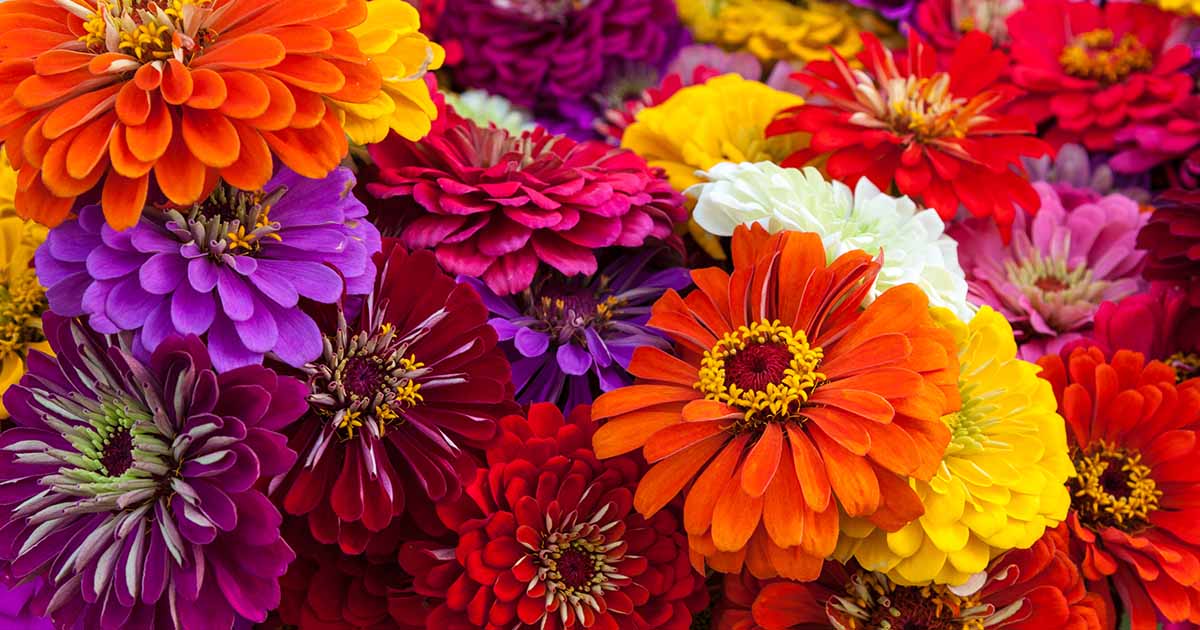
Zinnias are easy-to-grow annual flowers that provide non-stop color. Choose from many colors and forms including stars, dahlias, buttons, domes and quill-leaf cactus shapes.
Short zinnia cultivars such as ‘Magellan Series’ stay at knee height while the ‘Profusion’ and ‘Zahara’ hybrids are mildew resistant. Deadhead regularly for extended blooming. Zinnias are hummingbird magnets and butterflies love them.
BASIC

Zones:
Annual. Zinnias are suitable to be used in the winter season across all climates.
Height/Spread:
Variable by type. There are dwarf varieties that range from 6 to 12 inches wide and tall Some grow at 4 to 5 feet and 1 to 2 feet wide.
Exposure:
Full sun
Bloom Time:
The late spring season continues until the first frost, however it could be slower in blooming in the heat of summer. in the summer.
Color:
Flowers bloom in a variety of shades, including pink, orange white, red and yellow. There are tri-color and bi-color varieties. Leaves range from pale to mid-green.
Characteristics:
Zinnias are available in a range of flower shapes including dahlias, daisies, stars as well as buttons, spiders domes and quill-leaf shapes for cactus. Within these designs, there are semi-doubles, singles and doubles.
Toxicity:
Zinnias have no danger to grow around animals since they are not toxic to cats, dogs, and horses.
PLANTING ZINNIA SEEDS

Planting time:
If there’s no threat from frosts, the zinnias are able to be planted anytime from now until the close of June. It’s actually ideal to plant several rounds in 2-to 3 weeks intervals from now until June’s end to ensure that they bloom continuously throughout the autumn.
What to plant
Find your zinnias in an area that gets at least six hours of sunlight every day, and in an area that is a good drainage of the soil.
Planting:
Zinnias are the best to start from seeds and can be planted straight into the ground when the danger of frost has gone. Should you wish to jump on them and begin earlier indoors, you can use using peat containers or any other container which are planted into the ground. Zinnias tend to be somewhat finicky when transplanted. Seeds should be planted 1/4-inch deep. follow the spacing guidelines on the packages of seeds. Provide them with the sun and water, and seedlings will pop up within 4-7 days. The seedlings should be thinned to a spacing of 6-18 inches (depending on the variety) by cutting off the soil’s edge with scissors. (Tip Removing seedlings could disturb the roots of the ones that remain.) Zinnias are fast growing and will be displaying beautiful, flowers that are bright and vibrant in just 60 days.
CARE

Pruning:
If you’re looking for taller varieties of flowers that you would like to utilize for cutting flowers Floret Flower Farms recommends cutting off the center flower when the plants are around 18 inches high, and even though the process “feels pretty counterintuitive at the time, it will encourage plants to begin branching low and ultimately produce much longer stems.” Flowers that have been sucked are best deadheaded to promote and extend the blooms.
Soil:
Zinnias aren’t very picky regarding the soil they grow in, they prefer fertile, humus-rich and well-drained and having a pH range between 5.5 up to 7.5.
Amendments and Fertilizers:
Include compost in the area where zinnias are to be planted to improve the soil. A small amount of a balanced fertilizer could be administered, though it it’s not necessarily required.
Watering:
Regularly water, for approximately 1 inch every week. While they can withstand dry conditions, they’ll fare better when there is constant humidity on the ground. Make sure that excess moisture is kept away from the plant by watering the roots of the plant. This will ensure that your plant is healthy and help prevent diseases.
Propagation:
Seeds can be saved by letting the flower dry entirely on the plant. Take out the seeds by gently crushing the dried flower head. Keep the seeds in a dry, cool location to be planted in the spring. Be aware that hybrid seeds plants might not grow exactly like what the original plant.
Pests and Diseases:
Fungal and bacterial spots, white mildew and bacterial wilt could cause problems for Zinnias. Maintaining a dry foliage and ensuring adequate air circulation can aid in the elimination of. Zinnias can also be hosts of caterpillars mealsybugs or spider mites. It is recommended to eliminate caterpillars manually, however spider mites and mealybugs can be treated using insecticidal soap.
FAQ’S
–How to Start Zinnia Seeds?
Start zinnia seeds by planting them directly in the soil after the last frost. Plant them about ¼ inch deep, and keep the soil moist until the seeds germinate, which usually takes 5 to 10 days.
–What Are Zinnias?
Zinnias are annual flowering plants known for their bright, colorful blooms. They come in various shapes, sizes, and vibrant colors, making them popular for gardens and floral arrangements.
–How Long Do Zinnias Take to Grow?
Zinnias typically take about 60 to 70 days from planting to bloom. The exact timing can vary depending on the variety and growing conditions.
–Where to Plant Zinnias?
Zinnias thrive in full sun and well-drained soil. They prefer areas with at least 6–8 hours of sunlight per day. Plant them in a spot where they’ll get plenty of light for best growth.
–How Far Apart Should I Plant Zinnia Seeds?
Zinnia seeds should be planted about 6 to 12 inches apart, depending on the variety. This allows space for the plants to grow and spread without overcrowding.
–When to Water a Zinnia?
Water zinnias deeply once or twice a week, depending on the weather. It’s best to water at the base of the plant to avoid wetting the leaves, which can lead to fungal diseases.
–How to Feed Zinnias?
Zinnias benefit from a balanced, all-purpose fertilizer. Feed them about once a month during the growing season, but avoid excessive nitrogen, which can lead to fewer flowers and more leaves.
